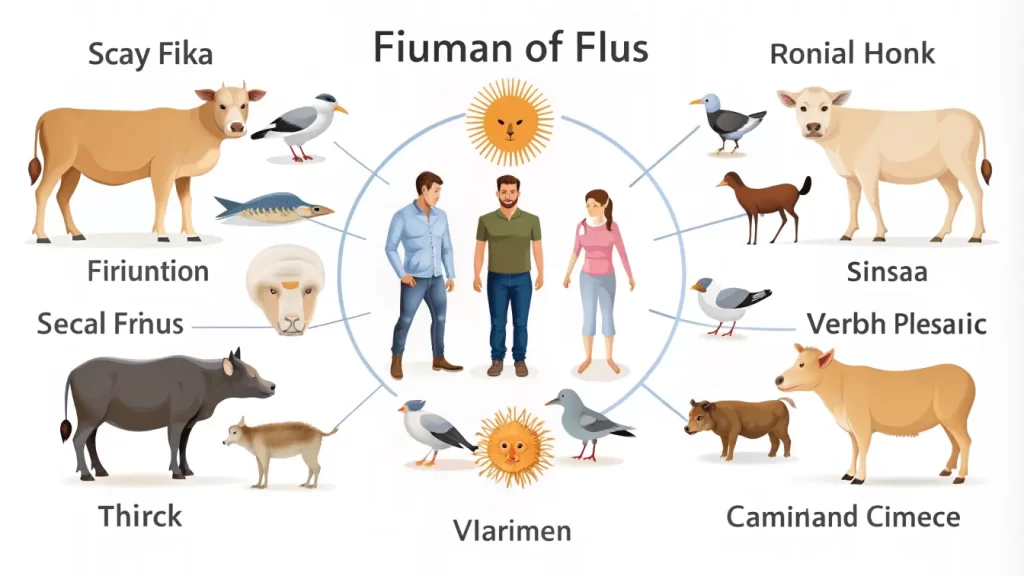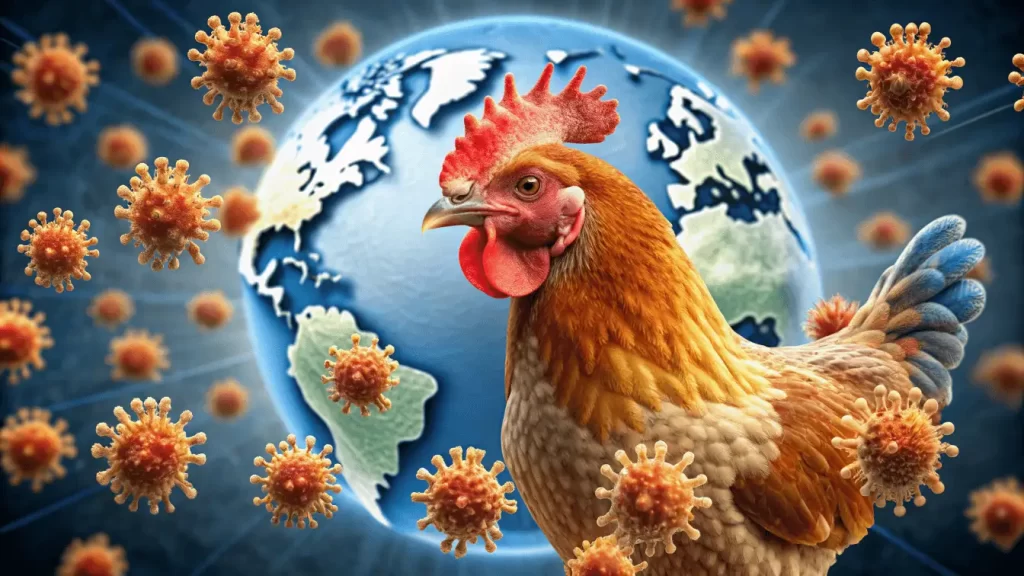Hey there! So, H5N1 the World Health Organization (WHO) has shared that a child who got Australia’s first human case of a “severe” subtype of bird flu probably caught it during a trip to India last month.
According to WHO, the virus is H5N1, which usually hangs around in Southeast Asia and has caused human infections before, as well as in poultry.
The WHO pointed out that though they are not sure where exactly the virus is from this time, chances are it happened in India – the country the child visited – where this specific type of A(H5N1) virus has been found in birds previously.
Victoria who traveled to Kolkata in West Bengal

Now, let’s talk about the little girl from Victoria who traveled to Kolkata in West Bengal, India, from February 12 to February 19, and then flew back to Australia on March 1 as WHO informed:
- Soon after arriving home, on March 2, she had to be taken to the hospital and was under care for over two weeks until she got better, per Victoria’s health department.
- As stated by WHO up till May 22, none of her close family both in Australia and India showed any symptoms.
- Additional details shared by the family tell us that she didn’t go anywhere else apart from Kolkata and didn’t have any contact with sick people or animals while she was there.
- Victoria’s Head Health Officer, Clare Looker, mentioned that it was unclear how the child caught the virus. She highlighted that when people get H5N1, it usually happens when they’re around poultry.
She explained, “That means being around poultry farms or at markets where there are birds, or if they’ve been around pet birds a lot.” She added, “Sometimes, handling infected birds’ meat or eggs can also pass on the virusClare pointed out, “We couldn’t pinpoint exactly how this child got infected, but we think it’s one of those reasons.“
Amesh Adalja, an expert in infectious diseases at Johns Hopkins Center for Health Security, shared that even though it would be tough to figure out now, an investigation should find out if the child was near poultry or other birds.
“H5N1 viruses do not transmit efficiently between humans and I suspect there’s an occult animal exposure that led to the infection” .
Table of Contents
WHO advises against travel restrictions?

The WHO mentioned that getting H5N1 from birds can make people very sick & might lead to death.
Between 2003 and 2024, there were 246 cases of H5N1 in people from four countries in the western Pacific area. The WHO said that out of these cases, 138 resulted in death.
- The WHO said that these A(H5N1) flu viruses come from different groups genetically and don’t infect humans easily. There hasn’t been much human-to-human spread so far.
- Because the virus is still around in chickens, especially in rural places, there might be more random cases in people.
- The WHO told everyone to stay away from places with a high risk like live animal markets, farms, live chickens, or spots that may have bird poop.
- The WHO doesn’t think we should stop traveling or trading because of this. They also don’t think we need to check travelers at entry points or put other limits because of the situation with flu bugs going between animals and people.
- If anyone is near animals that might have had the virus or dirty places and start feeling sick, they should go to the doctor ASAP and try not to be around other people too much.
Note: Kolkata is actually in West Bengal, not Western India.
Avian Influenza A (H5N1) – Australia

Situation at a glance
Hey there! On 22 May 2024, the World Health Organization (WHO) got a heads-up about a confirmed case of human infection with bird flu A(H5N1 virus (clade 2.3.2.1a) from Australia’s National Focal Point under the International Health Regulations (IHR).’s the first time has reported a confirmed human infection from this bird flu. While we don’t know for sure how the person got exposed to the virus, it probably happened in India where they had been, given that this specific type of A(H5N1) virus has shown up in birds there. According to IHR (2005), any new human infection from a different subtype of the flu is a big deal and needs to be reported to WHO right away. Based on what we know so far, WHO says the risk to everyone else from this virus is pretty low.
Description of the situation
On May 17, 2024, the WHO Collaborating Centre (WHO CC) for Reference and Research on Influenza in Australia reached out to the NFP of Australia about a possible case of human(H5N1) avian influenza (HPAI) in Melbourne, Victoria.
The lovely Victorian Department of Health officially confirmed this case on May 18, 2024. According to Article 44, the NFP of Australia shared news of the confirmed case with the NFP of India on May 21, 2024. Following Article 8 guidelines, the IHR NFP of Australia informed WHO about the case on May 22, 2024.
Now let’s talk about the brave little patient involved. She is a sweet 2.5-year-old girl with no underlying health issues. This little adventurer had recently traveled to Kolkata, India from February 12 to February 29, 2024. She made her way back to Australia on March 1, 2024.
Once back in Australia, she visited a hospital in Victoria on March 2, where she got some medical attention and was admitted later that day. By March 4, she had to be moved to the intensive care unit at a hospital in Melbourne due to worsened symptoms for one whole week. Thankfully, she was able to leave the hospital after being there for two and a half weeks and is now doing great!
During her time in Kolkata, India

- The family shared that they noticed their precious child feeling unwell starting from February 25 with signs like loss of appetite, irritability, and fever. After visiting a doctor in India on February 28, where she was given paracetamol for her feverish state with coughing and vomiting.
- Sadly, it wasn’t reported to an Australian airport biosecurity officer that she was unwell when she arrived back in Australia on March 1st.
- Additional details from the family revealed that during her time in Kolkata, India; she didn’t venture outside and didn’t come into contact with any sick individuals or animals. And thankfully as of May 22nd, no close family members either here or in India showed any symptoms.
Tests carried out at the referral hospital confirmed influenza A from samples taken on March & &7th even though there were concerns connecting her illness to the H5N1 virus at first by referring practitioners at the hospital.
Samples were sent off for further study at the WHO CC which ultimately confirmed subtype A(H5N1) based on genetic sequencing and pointed towards clade belonging to South-East Asia detected before both in humans and birds alike. So now we have a lot more information than we did before! How exciting!
Epidemiology
Animal flu viruses usually spread among animals but can also affect people. Human infections typically come from contact with sick animals or dirty areas. Influenza A viruses are grouped as bird flu, swine flu, or animal types.
When humans get avian flu, they can have mild to severe symptoms and even die. Symptoms may include eye infections, stomach problems, brain inflammation, and confusion. Some people with no symptoms have the virus after being near sick birds.
Tests are needed to confirm if a person has flu. The WHO updates ways to find zoonotic flu using scientific methods like RT-PCR. Some antiviral meds like oseltamivir and zanamivir can help fight the virus.
Since 2003, 891 cases of avian flu in humans have been reported by WHO from 24 countries, with 463 deaths. Most cases came from contact with sick birds or contaminated places.
India told WOAH about H5N1 bird flu in domestic birds in 2024. The virus is still around in chickens, so more human cases could happen. This is the first case of H5N1 bird flu in humans in Australia and likely came from India where this strain was seen before, but it’s not certain.
Public health response

Australia
- Hey there! So, the Australian Government Department of Health and Aged got together a Monitoring and Investigation Team (MIT). Their first meeting happened on 20 May 2024. Right now, the MIT meets weekly to check out any ongoing risks related to highly pathogenic avian influenza in Australia. This is all because of the confirmed case of H5N1 in Victoria and the international HPAI outbreaks going on. They might change how often they meet depending on what’s needed.
- The National Incident Centre of the Australian Government’s Department of Health and Care is up and running to coordinate a response.
- India’s IHR NFP got a heads-up on 21 May 2024.
- Moving on to 22 May 2024, Victoria’s Chief Health Officer put out a health advisory on their website. It was all about a new human case of avian influenza in Victoria.
- Then, on 23 May 2024, the Head of Australia’s interim Centre for Disease Control did a media release about Australia’s first human case of avian influenza A(H5N1) in Victoria. They also updated their website with some public health advice about avian influenza. This included a friendly reminder for folks who work with poultry or travel to countries with avian influenza outbreaks to get a seasonal flu shot each year. This can help stop avian influenza from mixing with other flu viruses and make new mutated viruses that could be more dangerous. Just looking out for everyone!
India
- When IHR NFP Australia let the Ministry of Health and Family Welfare in India know about it, they started checking things out with everyone involved. WHO looked into the risk too.
WHO risk assessment

Hey there! Australia just reported its first case of a person infected with an avian influenza A(H5N1) virus. Most of the time, people catch these types of viruses from being around sick birds or dirty places. It’s not clear where this person caught the virus, but it probably happened when they were in India before they got sick.
Getting infected with this virus can make you very sick and even be deadly. These A(H5N1) flu viruses aren’t good at infecting people easily, and passing it from one person to another is pretty rare right now. But since the virus is still around in birds, especially in rural areas, there might be more random cases in humans.
For now, experts think that these A(H5) viruses are not good at spreading between people for a long time, so the risk isn’t very high. Even though things could change if we find out more information about the virus. The World Health Organization says that the risk to most people from this virus is pretty low at the moment. They will keep checking and let us know if anything changes.
WHO advice
Hey there! Just a heads up, this latest happening doesn’t change what WHO suggests about public health precautions and keeping an eye on the flu.
- Everyone should steer clear of spots with higher risks, like live animal markets or farms, and anything that might have poultry poop on it. Plus, don’t forget to keep those hands squeaky clean by washing them often or using hand sanitizer.
- If you notice sick animals or animals unexpectedly kicking the bucket, make sure to let the vets know pronto. And skip chowing down on any poultry that seems under the weather or has passed away without warning.
Fe off after being around possibly infected critters or icky environments? Seek medical help right away, clue your doctor in on what you’ve been exposed to, mask up, and try to avoid close contact with others. Find more deets in the updated guidance over here.
Taking a close look at how things are shaping up epidemiologically, figuring out more about the latest influenza A(H5N1) viruses in humans and animals, and looking into serological investigations are crucial to understanding the risks involved and making quick adjustments as needed.
vaccines exist for influenza A(H5N1)
No specific vaccines exist for influenza A(H5N1) for humans. But some countries have come up with potential vaccines for potential pandemics down the line. WHO keeps an eye on zoonotic influenza candidates’ vaccine viruses (CVV), updating this list twice annually during consultations about influenza virus vaccine composition.
When it comes to travel or trade restrictions related to this event, WHO advises against jumping the gun based on current info available. As for screening travelers at border points or other restrictions due to flu viruses at the human-animal crossover zone right now? No need according to WHO.
Countries under IHR (2005) gotta tell the WHO right away if they find someone recently infected by a new subtype of flu virus – no need for sick evidence though.





